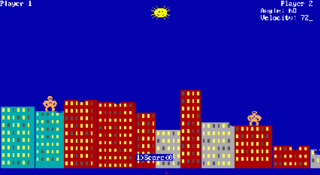LETBOTTLES=99:LETBOTTLES$="99":LETBOTTLE$=" bottles"FORA=1TO99PRINTBOTTLES$;BOTTLE$;" of beer on the wall, ";BOTTLES$;BOTTLE$;" of beer."LETBOTTLES=BOTTLES-1IFBOTTLES>0THENLETBOTTLES$=LTRIM$(STR$(BOTTLES)):LETPRONOUN$="one"IFBOTTLES=0THENLETBOTTLES$="no more":LETPRONOUN$="it"IFBOTTLES<>1THENLETBOTTLE$=" bottles"IFBOTTLES=1THENLETBOTTLE$=" bottle"PRINT"Take ";PRONOUN$;" down and pass it around, ";BOTTLES$;BOTTLE$;" of beer on the wall."PRINT:NEXTAPRINT"No more bottles of beer on the wall, no more bottles of beer."PRINT"Go to the store and buy some more, 99 bottles of beer on the wall."
SCREEN13DIMa(3976)ASINTEGER,b(3976)ASINTEGER,c(3976)ASINTEGERDIMd(3976)ASINTEGER,e(3976)ASINTEGERcol%=16:col1%=16:col2%=16:col3%=16:col4%=16col5%=16:col6%=16:col7%=16:flag=1:flag1=1flag2=1:flag3=1:flag4=1:flag5=1:flag6=1:flag7=1DOGET(1,38)-(318,62),aPUT(2,38),a,PSETLINE(1,38)-(1,62),col%IFflag=1THENcol%=col%+1:IFcol%=32THENflag=2IFflag=2THENcol%=col%-1:IFcol%=16THENflag=1GET(2,63)-(319,87),bPUT(1,63),b,PSETLINE(319,63)-(319,87),col1%IFflag1=1THENcol1%=col1%+1:IFcol1%=32THENflag1=2IFflag1=2THENcol1%=col1%-1:IFcol1%=16THENflag1=1GET(1,88)-(318,112),cPUT(2,88),c,PSETLINE(1,88)-(1,112),col2%IFflag2=1THENcol2%=col2%+1:IFcol2%=32THENflag2=2IFflag2=2THENcol2%=col2%-1:IFcol2%=16THENflag2=1GET(2,113)-(319,137),dPUT(1,113),d,PSETLINE(319,113)-(319,137),col3%IFflag3=1THENcol3%=col3%+1:IFcol3%=32THENflag3=2IFflag3=2THENcol3%=col3%-1:IFcol3%=16THENflag3=1GET(1,138)-(318,162),ePUT(2,138),e,PSETLINE(1,138)-(1,162),col4%IFflag4=1THENcol4%=col4%+1:IFcol4%=32THENflag4=2IFflag4=2THENcol4%=col4%-1:IFcol4%=16THENflag4=1LOOPUNTILLEN(INKEY$)
REM sample of bubble sortN=10DIMA(N)ASINTEGERFORL=1TONA(L)=INT(RND*10+1)NEXTFORX=1TONFORY=1TON-1IFA(X)<A(Y)THENSWAPA(X),A(Y)NEXTNEXTFORL=1TONPRINTA(L)NEXTEND









